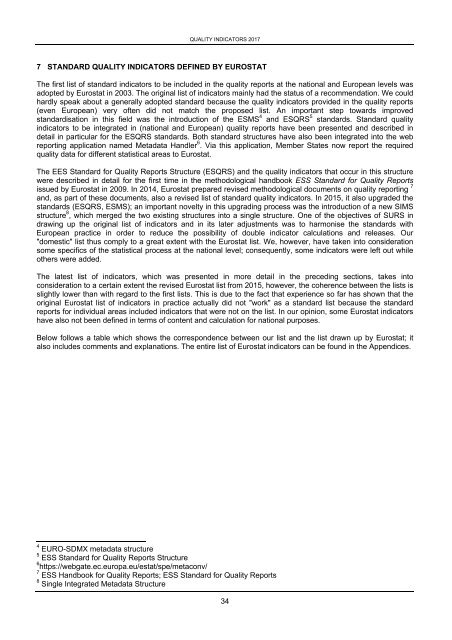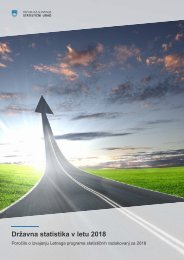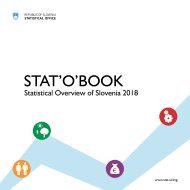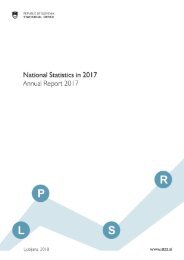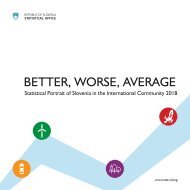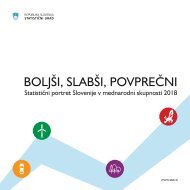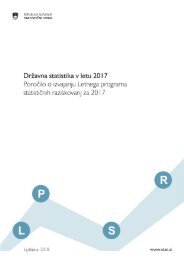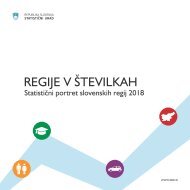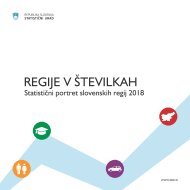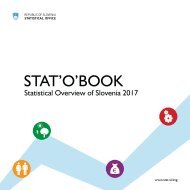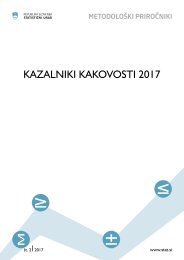quality-indicators-2017
You also want an ePaper? Increase the reach of your titles
YUMPU automatically turns print PDFs into web optimized ePapers that Google loves.
QUALITY INDICATORS <strong>2017</strong><br />
7 STANDARD QUALITY INDICATORS DEFINED BY EUROSTAT<br />
The first list of standard <strong>indicators</strong> to be included in the <strong>quality</strong> reports at the national and European levels was<br />
adopted by Eurostat in 2003. The original list of <strong>indicators</strong> mainly had the status of a recommendation. We could<br />
hardly speak about a generally adopted standard because the <strong>quality</strong> <strong>indicators</strong> provided in the <strong>quality</strong> reports<br />
(even European) very often did not match the proposed list. An important step towards improved<br />
standardisation in this field was the introduction of the ESMS 4 and ESQRS 5 standards. Standard <strong>quality</strong><br />
<strong>indicators</strong> to be integrated in (national and European) <strong>quality</strong> reports have been presented and described in<br />
detail in particular for the ESQRS standards. Both standard structures have also been integrated into the web<br />
reporting application named Metadata Handler 6 . Via this application, Member States now report the required<br />
<strong>quality</strong> data for different statistical areas to Eurostat.<br />
The EES Standard for Quality Reports Structure (ESQRS) and the <strong>quality</strong> <strong>indicators</strong> that occur in this structure<br />
were described in detail for the first time in the methodological handbook ESS Standard for Quality Reports<br />
issued by Eurostat in 2009. In 2014, Eurostat prepared revised methodological documents on <strong>quality</strong> reporting 7<br />
and, as part of these documents, also a revised list of standard <strong>quality</strong> <strong>indicators</strong>. In 2015, it also upgraded the<br />
standards (ESQRS, ESMS); an important novelty in this upgrading process was the introduction of a new SIMS<br />
structure 8 , which merged the two existing structures into a single structure. One of the objectives of SURS in<br />
drawing up the original list of <strong>indicators</strong> and in its later adjustments was to harmonise the standards with<br />
European practice in order to reduce the possibility of double indicator calculations and releases. Our<br />
"domestic" list thus comply to a great extent with the Eurostat list. We, however, have taken into consideration<br />
some specifics of the statistical process at the national level; consequently, some <strong>indicators</strong> were left out while<br />
others were added.<br />
The latest list of <strong>indicators</strong>, which was presented in more detail in the preceding sections, takes into<br />
consideration to a certain extent the revised Eurostat list from 2015, however, the coherence between the lists is<br />
slightly lower than with regard to the first lists. This is due to the fact that experience so far has shown that the<br />
original Eurostat list of <strong>indicators</strong> in practice actually did not "work" as a standard list because the standard<br />
reports for individual areas included <strong>indicators</strong> that were not on the list. In our opinion, some Eurostat <strong>indicators</strong><br />
have also not been defined in terms of content and calculation for national purposes.<br />
Below follows a table which shows the correspondence between our list and the list drawn up by Eurostat; it<br />
also includes comments and explanations. The entire list of Eurostat <strong>indicators</strong> can be found in the Appendices.<br />
4 EURO-SDMX metadata structure<br />
5 ESS Standard for Quality Reports Structure<br />
6 https://webgate.ec.europa.eu/estat/spe/metaconv/<br />
7 ESS Handbook for Quality Reports; ESS Standard for Quality Reports<br />
8 Single Integrated Metadata Structure<br />
34


